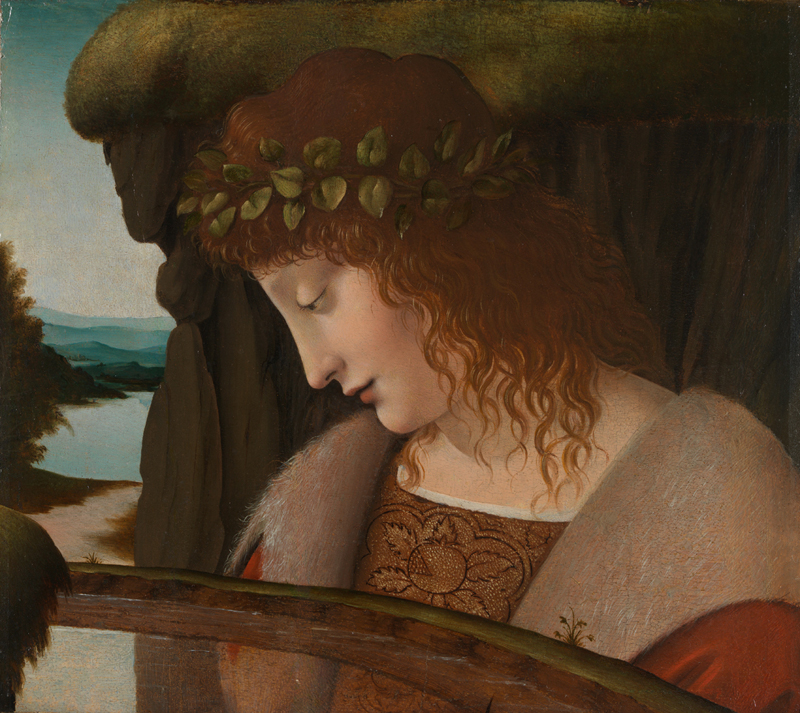Leonardo’s Legacy: Francesco Melzi and the Leonardeschi at The National Gallery in London
Francesco Melzi, 'Flora', about 1520 © The State Hermitage Museum, St. Petersburg, 2019. Photo: Vladimir Terebenin
The National Gallery in London is marking the 500th anniversary of Leonardo da Vinci’s death with a display presenting the exceptional loan (now through June 23, 2019) of the recently restored 'Flora' by Francesco Melzi from the State Hermitage Museum, St Petersburg.
The painting is being displayed alongside ten other key works by the so-called ‘Leonardeschi’ from the National Gallery Collection in a free, month-long display in Room 12. This is the first time the painting has been seen in the UK and the first time it has been seen outside of Russia since its restoration.
Francesco Melzi (1493–1570) was a wealthy gentleman of Milan, and the favoured assistant and companion to Leonardo in his final years. As his primary heir, he was largely responsible for preserving Leonardo’s notebooks and drawings for posterity.
Though Leonardo’s writings and inventions were not given due recognition for centuries, the legacy of his painting style was immediate and substantial. The term ‘Leonardeschi’ has since been used to identify artists centred in Milan who were taught by or associated with Leonardo, or whose work bears his influence.
This exquisite painting by Francesco Melzi depicts Flora, the goddess of springtime and flowers, seated in a leafy grotto sprouting with fern and ivy. Flora’s exposed breast and the way she tenderly inspects a sprig of aquilegia – a symbol of fertility – emphasise her role as ‘mother of flowers’. On her lap she caresses a spray of jasmine, signifying purity, beside anemones representing rebirth.
Recent restoration undertaken by the State Hermitage Museum has uncovered the picture’s true colours, including the powerful ultramarine blue; and hidden details have been revealed, such as the flowers growing from the walls of the dimly lit grotto. Infrared reflectography has also shown that Melzi ensured anatomical correctness by modelling Flora’s naked figure before adding her clothing.
The painting reflects the influence of Melzi’s teacher, Leonardo, to whom it was attributed at the time of its acquisition from the Dutch Royal collection in 1850. The female facial type with its downcast look is characteristic of Leonardo’s Milanese style, as is the mastery of subtle modulations of tone, known as ‘sfumato’. Melzi has taken Leonardo’s meticulous approach to painting plants and also replicates the complex hair-styling he uses in other portraits.
Francesco Melzi, 'Flora', about 1520. Detail: Flora holds up aquilegia (also called columbine), a symbol of fertility. © The State Hermitage Museum, St. Petersburg, 2019. Photo: Vladimir Terebenin.
Francesco Melzi, 'Flora', about 1520. Detail: Flora holds a sprig of jasmine, signifying purity. © The State Hermitage Museum, St. Petersburg, 2019. Photo: Vladimir Terebenin.
Francesco Melzi, 'Flora', about 1520. Detail: Lurking in the folds of her cloak are anemones, which represent rebirth. They also have a special meaning in the context of the painting: in ancient Greece the anemone was the flower of the wind, and Flora was married to Zephyr, the god of the West Wind. © The State Hermitage Museum, St. Petersburg, 2019. Photo: Vladimir Terebenin.
Director of the National Gallery, Dr Gabriele Finaldil says, “We are delighted to be able to mark the 500th anniversary of Leonardo da Vinci’s death with a display presenting the exceptional loan of the recently restored ‘Flora’ by Francesco Melzi .The State Hermitage Museum has long-standing and close ties to the National Gallery and this Room 12 display is a superb example of international museums working together.”
Professor Piotrovsky, Director of the State Hermitage Museum, St. Petersburg,says,
“We are excited to have loaned ‘Flora’ by Francesco Melzi to the National Gallery and to see her as the central focus of this fascinating display which explores the work of Leonardo’s closest friends and disciples. This represents the first time that ‘Flora’ has been seen outside of Russia since it was restored by Maria Shulepova, revealing details and rich colouring which had been lost for decades under layers of old varnish. We hope that visitors in London will enjoy seeing this rare masterpiece by Leonardo’s favourite pupil, and we are pleased to further strengthen our long and valued friendship with the National Gallery.”
Francesco Melzi, 'Vertumnus and Pomona', 1518-28. Gemaeldegalerie - Staatliche Museen zu Berlin © Photo Scala, Florence/bpk, Bildagentur fuer Kunst, Kultur und Geschichte, Berlin
The Leonardeschi
Leonardo’s scientific discoveries and inventions were not given due recognition for centuries, but his painting style made an immediate impact on artists. The term ‘Leonardeschi’ has since been coined to identify painters in or near Milan who were taught by or associated with Leonardo, or whose work bears his influence.
The display at the Gallery features works by Giovanni Antonio Boltraffio (about 1467–1516), Marco d’Oggiono (active from 1487–died 1524), Giampietrino (active about 1500–1550), Bernardino Luini (about 1480–1532), and Martino Piazza (active about 1513–1522), among others.
In his painting, Leonardo pioneered the combination of detailed naturalism and ‘divine grace’, with which he sought to surpass the beauty of nature. His followers absorbed different characteristics of their master’s art, in particular his elegant compositions, meticulous rendering of plants, hair and dreamlike landscapes, and the blurred outlines he used to model forms, known as ‘sfumato’. In Leonardo’s words: ‘The true outlines of opaque bodies are never seen with sharp precision’.
Follower of Giovanni Antonio Boltraffio, 'Narcissus', probably about 1500. Oil on walnut, 23.2 × 26.5 cm. Salting Bequest, 1910, NG2673. © 2019 The National Gallery.

/https%3A%2F%2Fprofilepics.canalblog.com%2Fprofilepics%2F1%2F0%2F100183.jpg)
/https%3A%2F%2Fstorage.canalblog.com%2F03%2F02%2F119589%2F96711876_o.jpg)
/https%3A%2F%2Fstorage.canalblog.com%2F11%2F31%2F119589%2F94773502_o.jpg)
/https%3A%2F%2Fstorage.canalblog.com%2F20%2F83%2F119589%2F94772815_o.jpg)
/https%3A%2F%2Fstorage.canalblog.com%2F26%2F72%2F119589%2F75604929_o.jpg)
/https%3A%2F%2Fstorage.canalblog.com%2F59%2F60%2F119589%2F26458628_o.jpg)











/http%3A%2F%2Fstorage.canalblog.com%2F49%2F41%2F119589%2F110176979_o.jpg)
/image%2F1371349%2F20240418%2Fob_ac5c4c_telechargement.jpg)
/image%2F1371349%2F20240418%2Fob_709b64_304-1.jpg)
/image%2F1371349%2F20240418%2Fob_22f67e_303-1.jpg)